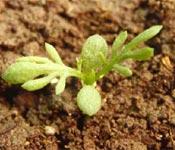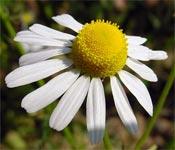Other Names – Scentless Mayweed
Family – Sunflower Asteraceae
Similar Species – Wild Chamomile (Matricaria chamomilla); Stinking Mayweed (Anthemis cotula)
Life Cycle – annual, winter annual, biennial, simple perennial
Habitat – conventional and reduced tillage, forage crops, hay fields, irrigation, turf, roadsides, waste areas
Key Features
- Finely-divided leaves
- Noticeable lack of odor
- Daisy-like heads at full maturity resemble a badminton shuttlecock
Seedling
Cotyledons are oval and sessile. The first true leaves are deeply-divided, often into five distinct segments. Both cotyledons and true leaves are smooth. Seedlings may be easily confused with flixweed. Flixweed cotyledons are stalked and narrower than scentless chamomile. In addition, the true leaves of flixweed are usually tri-lobed and hairy.
Juvenile
Scentless chamomile forms a rosette of finely-divided leaves. The leaves are almost fleshy in texture and have no odor when crushed. The sometimes confusing wild chamomile and pineappleweed have a pleasant aroma while ox-eye daisy can be distinguished from scentless chamomile by its spoon-shaped, lobed leaves. The stems produced by scentless chamomile are erect, smooth and often much-branched.
Mature
Small, daisy-like heads are found singly at the ends of the branches. Each head has tiny yellow disk flowers in the center surrounded by flat, white ray flowers. When the heads are ripe, the white flowers tend to point backwards, giving the entire head the appearance of a badminton shuttlecock. At first glance, the heads of wild chamomile look very much like scentless chamomile. With closer inspection, it is possible to see that the receptacle of scentless chamomile is more rounded than the conical-shaped receptacle of wild chamomile. Each yellow flower produces a seed that is dark brown with three white ribs on one side. The seeds do not have a hair-like pappus.
 |
 |
 |
